Mollie Brown Shares 19 Companion Plants To Grow Alongside Hydrangeas

SHRUBS > HYDRANGEA > COMPANIONS
Reviewed By COLIN SKELLY

Colin is a Horticulturist and Horticultural Consultant with experience in a range of practical and managerial roles across heritage, commercial and public horticulture. He holds the Royal Horticultural Society’s Master of Horticulture award and has a particular interest in horticultural ecology and naturalistic planting for habitat and climate resilience.
IN THIS GUIDE
- 1) Chinese Astilbe
- 2) Snapdragons
- 3) Purple Cranesbill
- 4) Common Box
- 5) Lamb’s Ear
- 6) Cape Jasmine
- 7) Coral Bells
- 8) Red-Barked Dogwood
- 9) Lily Of The Valley Bush
- 10) Catmint
- 11) Japanese Maple
- 12) Garden Speedwell
- 13) Common Foxglove
- 14) Japanese Pittosporum
- 15) Eulalia
- 16) Vase Vine
- 17) Siebold’s Plantain Lily
- 18) Blue Fescue
- 19) Common Yew
HYDRANGEA GUIDES
Climbing Hydrangea
Companion Planting
Container Growing
Cuttings Propagation
Drying Flowers
Keeping Flowers Blue
Leaves Turning Brown
Pruning
Varieties
– Dwarf Varieties
Hydrangeas are hardy perennial climbers or shrubs which are widely loved and grown in gardens across the UK.
Though their needs can vary by type, they generally grow best in part shade – and in a growing medium that is kept moist but is not allowed to become waterlogged.
With this in mind, most hydrangea companion plants will need to tolerate damp but well-drained soil and part sun.
In this guide, we share nineteen companions for you to plant alongside your hydrangeas that will not only thrive in the same environment – they’ll add ornamental (and often practical) value.
1) Chinese Astilbe
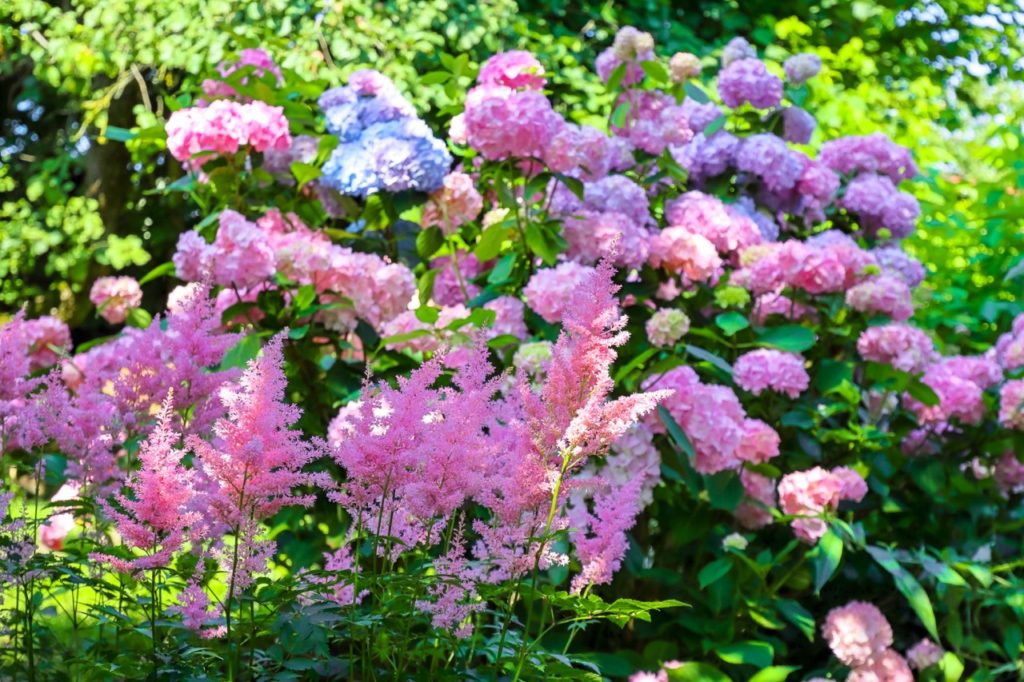
- BOTANICAL NAME: Astilbe chinensis
- HARDINESS RATING: H7
- PLANT TYPE: perennial
- FOLIAGE TYPE: deciduous
- FLOWERS: pink
- FLOWERING SEASON(S): summer
- SIZE: 0.5-1m in height, 0.5-1m spread
If it’s a bright array of summer colour you’re looking for, astilbes are a great choice for planting next to hydrangeas.
Chinese astilbe produces bright pink blooms on upright stems that are said to resemble the iconic look of a goat’s beard.
They can reach up to 1m tall and their spiky flowers will create a highly interesting contrast when companion planted next to or in front of a shrubby or climbing hydrangea.
A low-maintenance and hardy plant, astilbe will perform well in many areas of your garden with little care, so it’s a great choice if you are new to gardening or just want to grow something that is a little easier than some others on this list.
2) Snapdragons
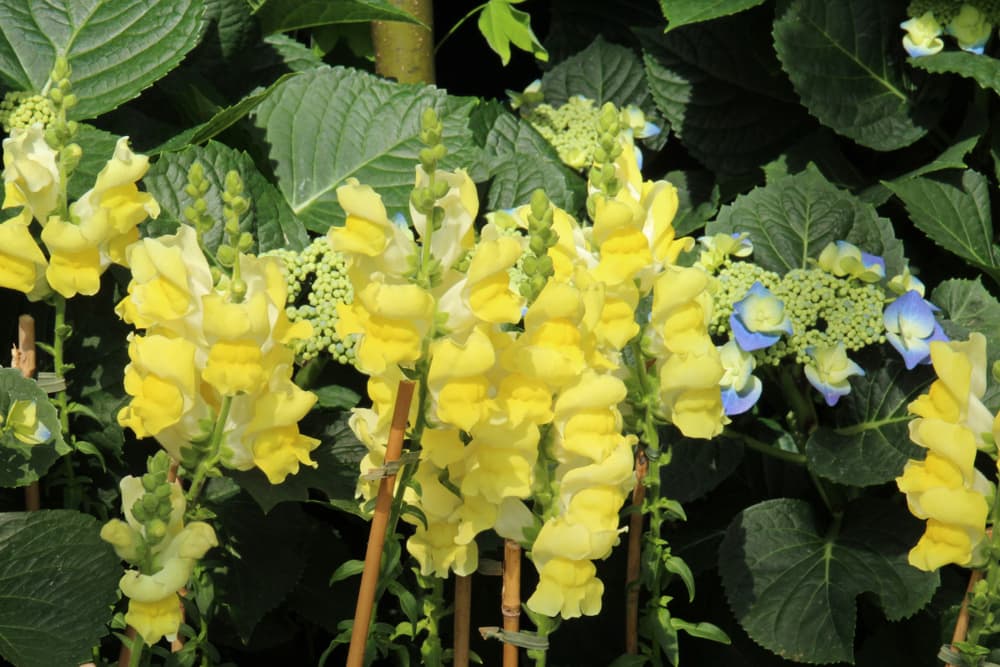
- BOTANICAL NAME: Antirrhinum majus
- HARDINESS RATING: H2
- PLANT TYPE: perennial / annual
- FOLIAGE TYPE: deciduous
- FLOWERS: varies
- FLOWERING SEASON(S): spring / summer / autumn
- SIZE: 1.5-2.5m in height, 0.1-0.5m spread
Snapdragons are beautiful plants most-often grown as annuals that come in a wide variety of colours from bright pinks to more muted creams.
Their huge range of colours works great as you can choose one that is right for pairing with your hydrangeas.
They are frost-tender plants and are unlikely to return the following year if you plant them directly into the ground, so if you’re looking for a more permanent feature, grow them in a pot with your hydrangeas and move the display to a warmer location during the winter months.
These gorgeous plants do best in a sheltered site that receives full sun.
3) Purple Cranesbill

- BOTANICAL NAME: Geranium x magnificum
- HARDINESS RATING: H7
- PLANT TYPE: perennial
- FOLIAGE TYPE: deciduous
- FLOWERS: blue and purple
- FLOWERING SEASON(S): summer
- SIZE: 0.5-1m in height, 0.5-1m spread
If you want to create a low-maintenance display, purple cranesbill is another hardy perennial to consider.
With purple star-shaped flowers growing in abundance from stems up to 1m tall, this plant will pair brilliantly with most varieties of hydrangea and will help to put on a visually striking summer show.
This perennial is easy to care for and will cope well in most soils and growing positions – perfect as a companion for that spot in the corner of your garden that other plants can’t tolerate.
4) Common Box

- BOTANICAL NAME: Buxus sempervirens
- HARDINESS RATING: H6
- PLANT TYPE: shrub / tree
- FOLIAGE TYPE: evergreen
- FLOWERS: yellow
- FLOWERING SEASON(S): spring
- SIZE: 4-8m in height, 4-8m spread
Buxus sempervirens, also known as ‘Box’ or ‘Boxwood’, is a small tree or shrub that can grow up to 8m high and wide – and which produces tiny yellow flowers in the spring.
This evergreen shrub is hardy and tolerant of a range of growing conditions, making it a great choice for planting with your hydrangea shrubs.
The green foliage will provide a stunning backdrop to any coloured blooms and can even be pruned into different shapes depending on whether your garden displays are more formal or not.
In the arrangement above you can see the use of Marigolds to add bright, attention-grabbing colour alongside a large shrubby Box and a Panicled hydrangea shrub.
5) Lamb’s Ear

- BOTANICAL NAME: Stachys byzantina
- HARDINESS RATING: H7
- PLANT TYPE: perennial
- FOLIAGE TYPE: evergreen
- FLOWERS: purple
- FLOWERING SEASON(S): summer
- SIZE: 0.1-0.5m in height, 0.5-1m spread
If you’re looking for a good ground cover plant that can grow well in similar conditions to your hydrangeas, ‘Lamb’s Ear’ is an option to consider.
With silvery foliage and clusters of purple flowers that grow on upright stems, this evergreen is a great choice for any summer flower beds.
Much like boxwood, the leaves will act as a nice backdrop for your hydrangea blooms, whilst the summer flowers it produces will add a bit of colour to the bottom of your garden beds or borders.
6) Cape Jasmine

- BOTANICAL NAME: Gardenia jasminoides
- HARDINESS RATING: H1C
- PLANT TYPE: shrub / houseplant
- FOLIAGE TYPE: evergreen
- FLOWERS: white
- FLOWERING SEASON(S): summer / autumn
- SIZE: 1-1.5m in height, 1-1.5m spread
Although this is a frost-tender plant, cape jasmine can look lovely when growing against a trellis or wall next to climbing hydrangeas, with stunning star-shaped white flowers appearing in the summer and autumn months.
You could opt for growing this gorgeous evergreen as an annual, but I would recommend growing it in a pot with a more tender hydrangea variety.
This way, you could enjoy the display in the summer months outdoors; then move the container inside your home or a heated greenhouse when the first frosts hit.
7) Coral Bells
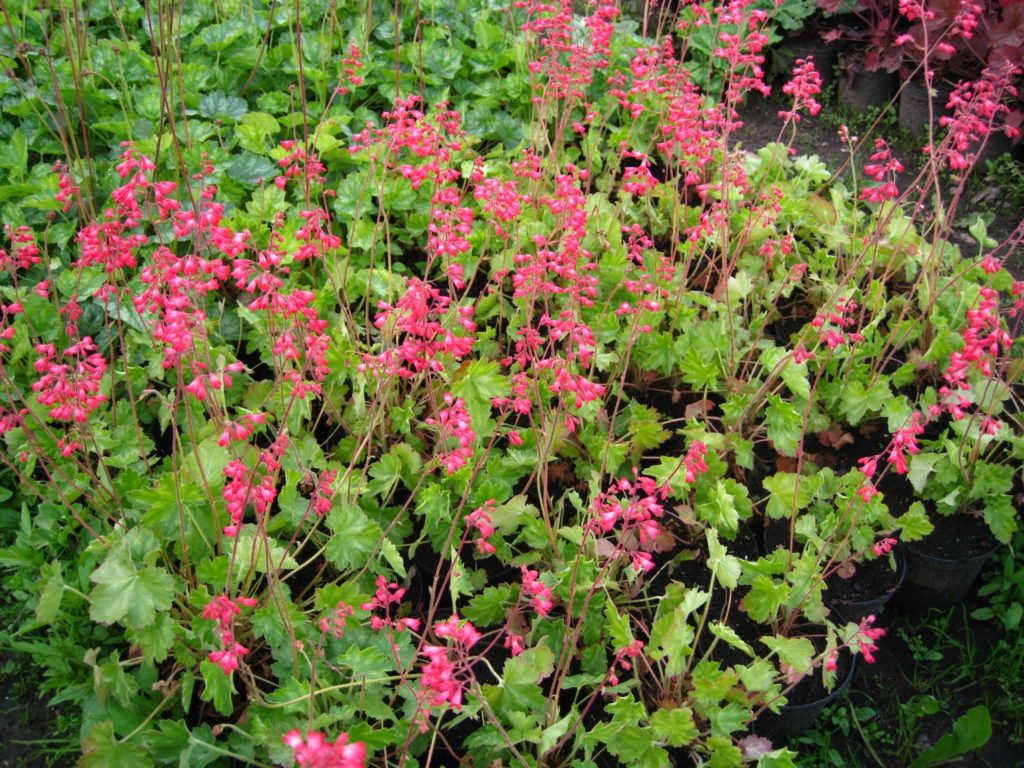
- BOTANICAL NAME: Heuchera
- HARDINESS RATING: H6
- PLANT TYPE: perennial
- FOLIAGE TYPE: semi-evergreen
- FLOWERS: red
- FLOWERING SEASON(S): summer
- SIZE: 0.1-0.5m in height, 0.1-0.5m spread
Another summer flowering plant, Coral Bells is actually commonly grown for its foliage rather than its beautiful red bell-shaped blooms.
Its lobed leaves can come in shades of purple, green or red depending on the variety and will last throughout most of the year, making it a great choice to plant around hydrangeas for some leafy interest.
As you can see in the image above, it makes sense to grow Heuchera in a shaded area where you need to cover a good amount of ground.
8) Red-Barked Dogwood
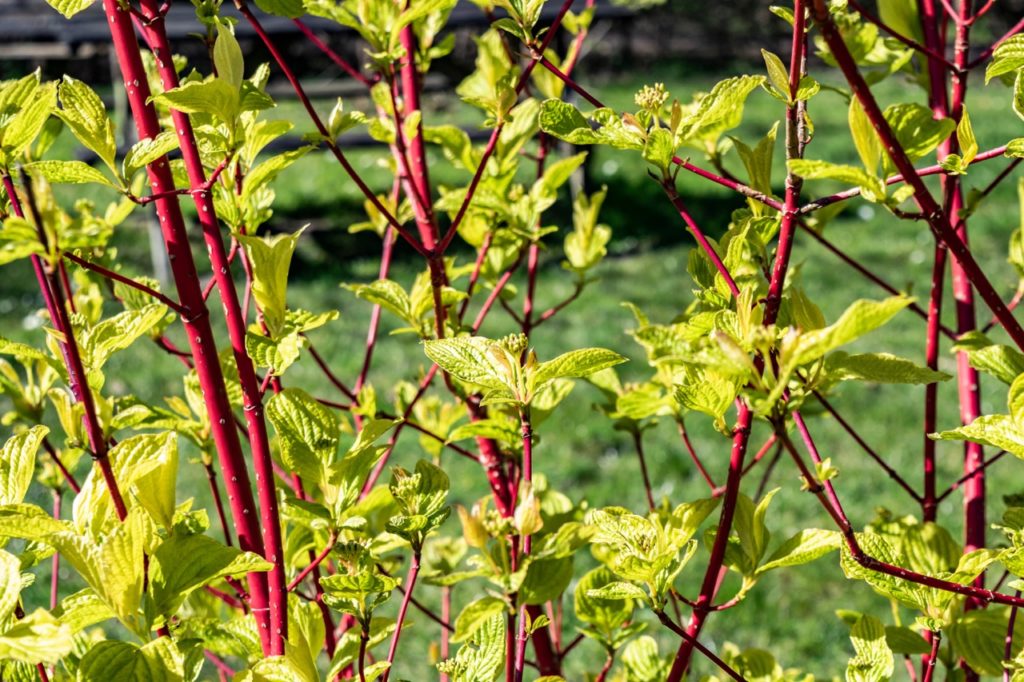
- BOTANICAL NAME: Cornus alba L.
- HARDINESS RATING: H7
- PLANT TYPE: shrub
- FOLIAGE TYPE: deciduous
- FLOWERS: cream
- FLOWERING SEASON(S): spring / summer
- SIZE: 2.5-4m in height, 2.5-4m spread
Dogwood is a popular shrub (also grown as a tree) here in the UK; popular for its red stems that provide a splash of colour even in the winter when the rest of the plant has died back.
This variety is a fully hardy perennial that produces lovely creamy flowers throughout the first half of the year, which are followed by white berries in the autumn.
Cornus alba grows up to 4m in height and spread – and could provide some much-needed shade for your hydrangea plants if grown behind them.
9) Lily Of The Valley Bush
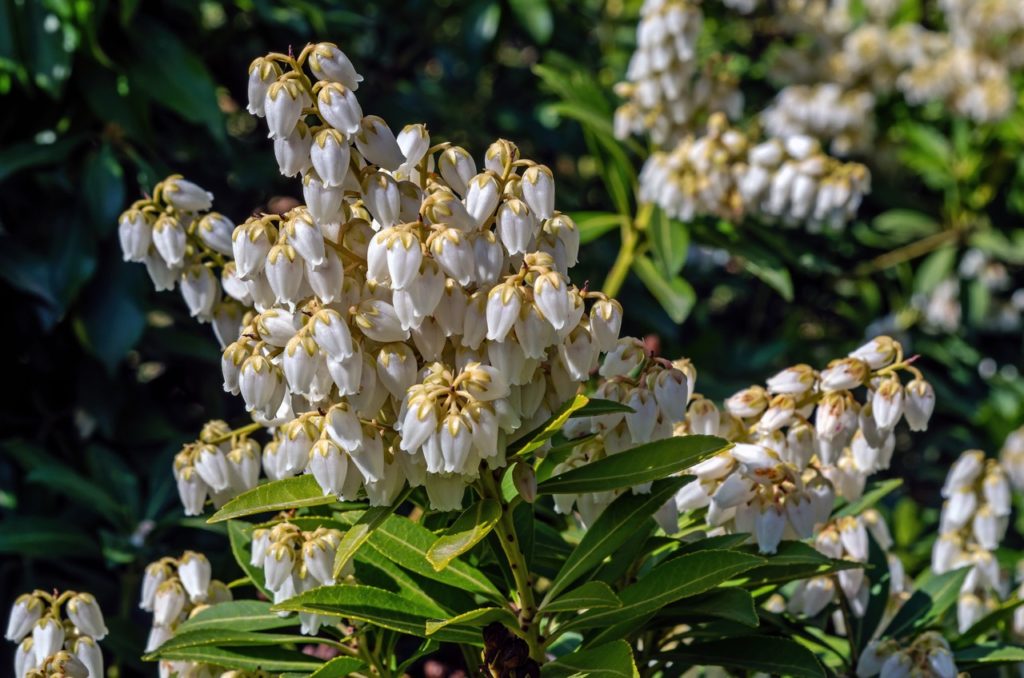
- BOTANICAL NAME: Pieris japonica
- HARDINESS RATING: H5
- PLANT TYPE: shrub
- FOLIAGE TYPE: evergreen
- FLOWERS: white
- FLOWERING SEASON(S): spring
- SIZE: 2.5-4m in height, 2.5-4m spread
With white bell-shaped flowers that appear in clusters in the spring, Pieris japonica, or the ‘Lily of the Valley’ bush, is another hardy shrub that can cast occasional shade on your hydrangea to help them thrive.
This delightful evergreen will grow best in acidic soil, with the blue blooms of your ericaceous hydrangeas creating a complementary display when paired with this medium-sized shrub.
Lily of the valley is also great for container cultivation but will need to be planted in a large pot if you want to grow hydrangeas alongside it.
Because it is rhizomatous and fast-spreading, it is generally advised to grow it in containers anyway, so this shouldn’t be too much of a deviation from how this plant is traditionally grown here in the UK.
10) Catmint

- BOTANICAL NAME: Nepeta cataria
- HARDINESS RATING: H7
- PLANT TYPE: perennial
- FOLIAGE TYPE: deciduous
- FLOWERS: purple and white
- FLOWERING SEASON(S): summer / autumn
- SIZE: 0.5-1m in height, 0.5-1m spread
Nepeta cataria, or catmint, is a colourful perennial that has clusters of colourful flowers that appear in the summer and autumn months.
Their flowers are not just a delight for you and your garden, but for the pollinators that you wish to attract as well.
Beloved by bees, catmint grows well in similar conditions to hydrangeas, making it a wonderful companion to grow in a low-maintenance planting scheme.
Just make sure this plant receives plenty of sun, as, unlike hydrangeas, it does not cope well with too much shade.
11) Japanese Maple
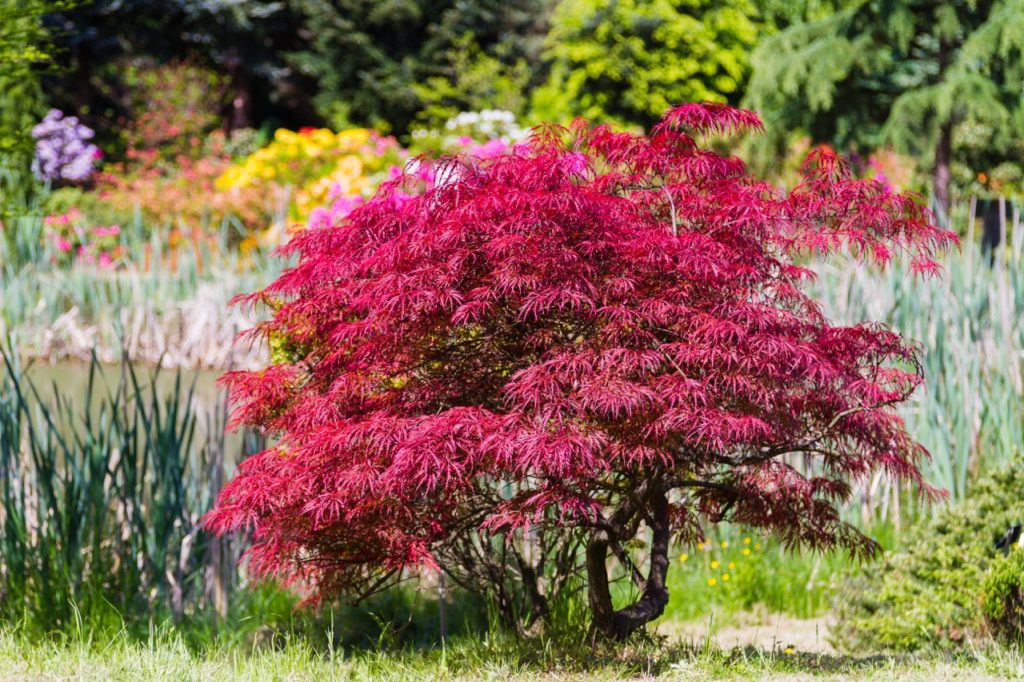
- BOTANICAL NAME: Acer palmatum
- HARDINESS RATING: H6
- PLANT TYPE: tree
- FOLIAGE TYPE: deciduous
- FLOWERS: red
- FLOWERING SEASON(S): spring
- SIZE: 4-8m in height, 4-8m spread
The first ‘proper’ tree on this list, the Japanese Maple grows up to 8m in height and spread; can cope well in the same growing conditions as hydrangeas and provide shade for them on summer days where the sun is perhaps a little too strong.
This plant produces beautiful red leaves that last until autumn, returning again after the worst of the cold weather is over in the early spring.
I love the Japanese maple for its distinctive foliage – and it’s perfect for gardens that perhaps don’t have the size for a larger specimen but are still interested in growing a tree.
12) Garden Speedwell
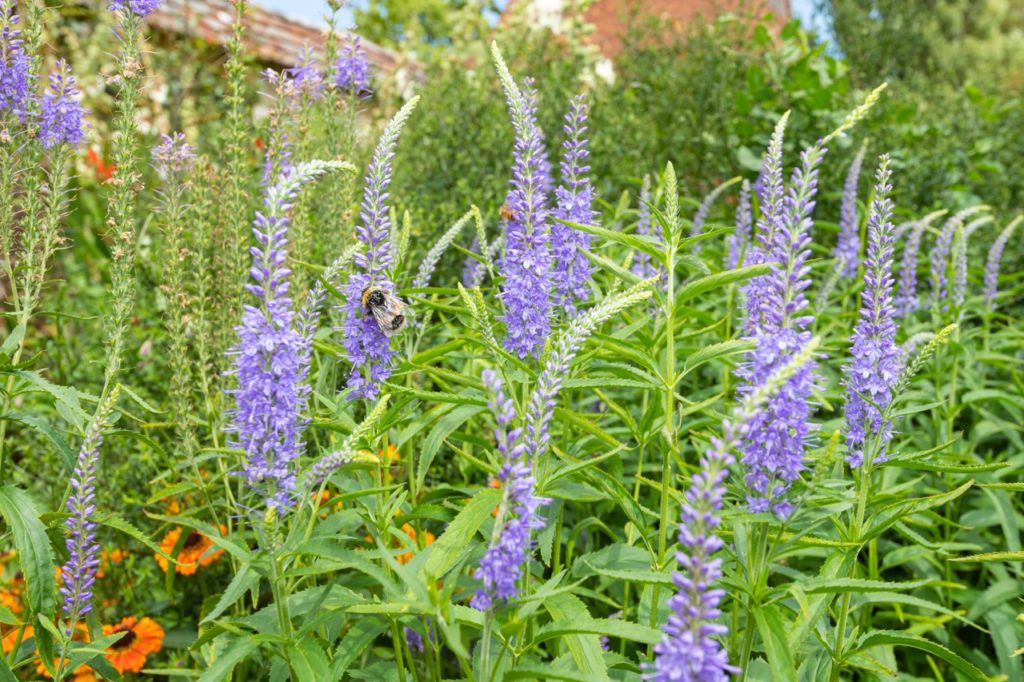
- BOTANICAL NAME: Veronica longifolia
- HARDINESS RATING: H7
- PLANT TYPE: perennial
- FOLIAGE TYPE: deciduous
- FLOWERS: blue
- FLOWERING SEASON(S): summer / autumn
- SIZE: 1-1.5m in height, 0.1-0.5m spread
A great choice for a wildlife-friendly garden, speedwell is a hardy perennial that produces flowers on upright stems.
These flowers will appear in summer and will look great when companion planted with the ruffled blooms of hydrangea shrubs.
This plant looks quite similar to lavender, but the flowers are more of a blueish shade and, unlike the sun-loving, drought-tolerant herb, garden speedwell is much less fussy and (arguably) easier to grow.
As speedwell is quite versatile, you can grow it as a hedge or in your garden beds or borders – it can adjust to suit the location of your existing hydrangeas.
13) Common Foxglove

- BOTANICAL NAME: Digitalis purpurea
- HARDINESS RATING: H7
- PLANT TYPE: biennial
- FOLIAGE TYPE: deciduous
- FLOWERS: purple
- FLOWERING SEASON(S): summer
- SIZE: 1.5-2.5m in height, 0.1-0.5m spread
Producing flowers that grow on upright stems up to 2.5m tall, foxgloves are an intriguing choice to plant alongside hydrangeas in a traditional cottage garden or in a more natural planting scheme.
“I have found foxgloves to be amazingly versatile in combining with many different types and styles of planting, from woodland areas to herbaceous borders, to more formal planting,” shares Horticultural Consultant Colin Skelly.
“Because it self-seeds freely, it should always be possible to either harvest the seeds or seedlings to keep it going.”
These unfussy plants grow well in shade and will thrive in conditions similar to hydrangeas.
You may consider growing them as companions in a container as shown in the image above.
Just be aware that these plants are short-lived biennials and will only last for two years – one of which will be dormant without any flowering.
You can plant them on alternate years and allow them to self-seed if you’d like them to flower every year alongside hydrangeas in your garden.
14) Japanese Pittosporum
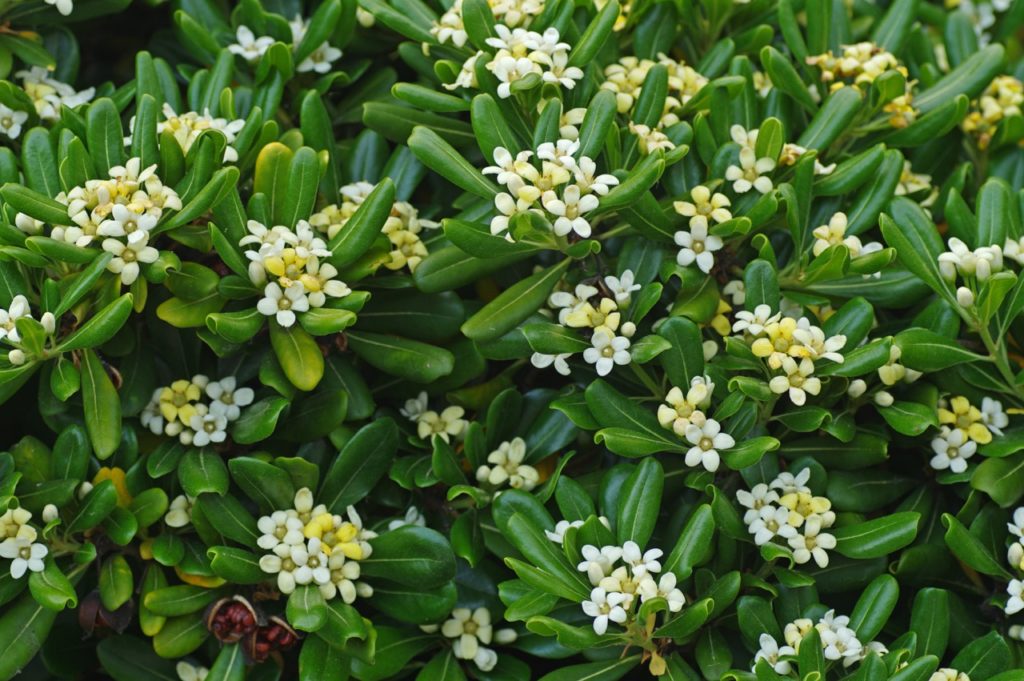
- BOTANICAL NAME: Pittosporum tobira
- HARDINESS RATING: H3
- PLANT TYPE: houseplant / shrub
- FOLIAGE TYPE: evergreen
- FLOWERS: white and yellow
- FLOWERING SEASON(S): spring / summer
- SIZE: 2.5-4m in height, 1.5-2.5m spread
Pittosporum tobira, more often referred to as ‘Japanese Pittosporum’ is a half-hardy shrub that produces dainty white flowers in the shape of stars in the spring and summer; which will make a prime contribution to your flowering displays.
The dark leaves from this shrub are not only a great backdrop for their own blooms but will act as a nice support for the lovely colours of your hydrangea flowers.
This versatile plant can be grown as a hedge or in your borders and beds, only reaching 4m in height with around half the spread.
15) Eulalia
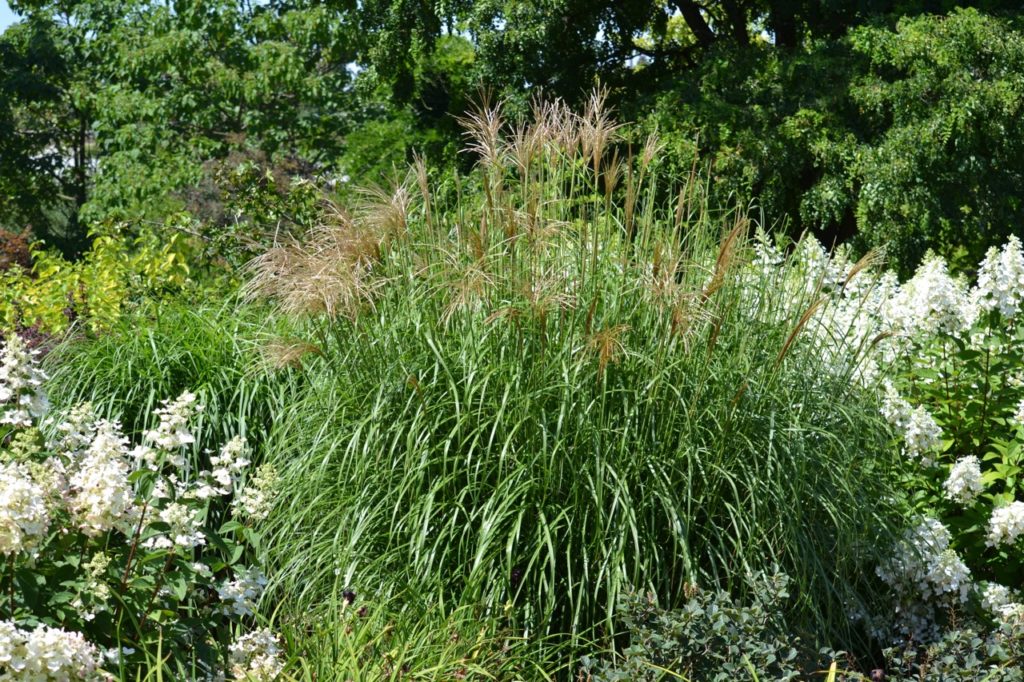
- BOTANICAL NAME: Miscanthus sinensis
- HARDINESS RATING: H6
- PLANT TYPE: grass / perennial
- FOLIAGE TYPE: deciduous
- FLOWERS: grey, pink and silver
- FLOWERING SEASON(S): summer / autumn
- SIZE: 2.5-4m in height, 1-1.5m spread
Eulalia is a great choice if you want your hydrangeas to be the stars of the show.
Although it can grow up to 4m in height, this perennial grass produces pale creamy flowers that will really help accentuate the beautiful blooms of a shrub.
As long as Eulalia gets plenty of sun, it is a relatively easy plant to care for once planted out.
16) Vase Vine
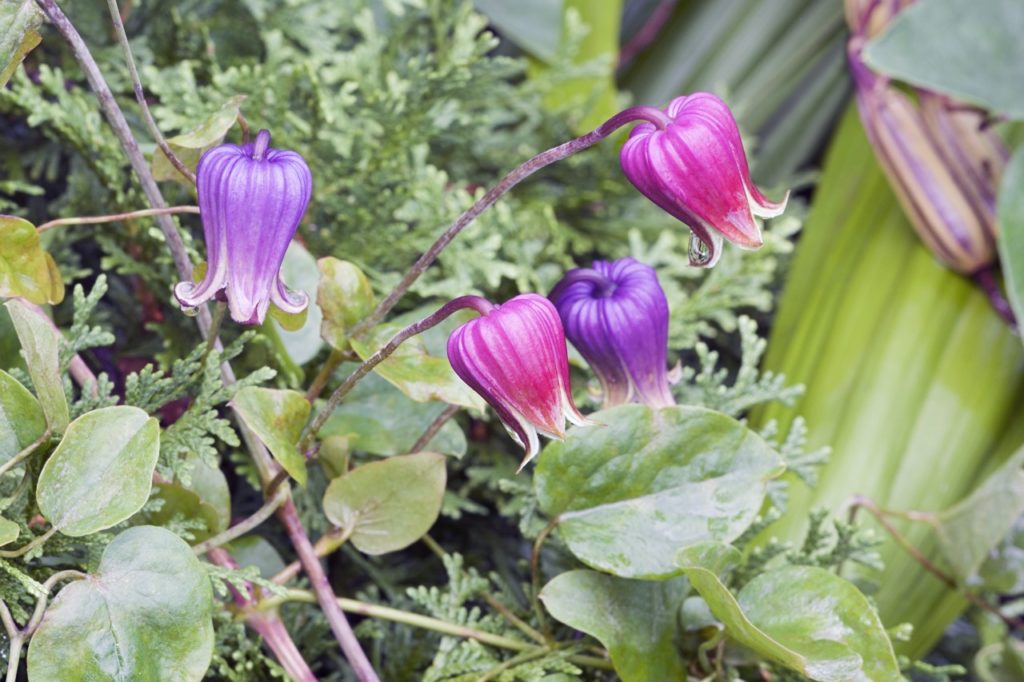
- BOTANICAL NAME: Clematis viorna
- HARDINESS RATING: H4
- PLANT TYPE: climber / perennial
- FOLIAGE TYPE: deciduous
- FLOWERS: pink and purple
- FLOWERING SEASON(S): spring / summer / autumn
- SIZE: 2.5-4m in height, 1-1.5m spread
Possibly my favourite pick on this list, Clematis viorna, or the ‘Vase Vine’, is a deciduous climber that can be companion planted with a climbing hydrangea against a wall or a trellis.
This clematis variety thrives in partial shade just like hydrangea and produces stunning pink and purple bell-shaped flowers from April to September.
These small flowers would provide a little pop of colour to complement the hydrangea’s gorgeous flowering clusters.
If you have a trellis or structure behind your shrubs or border then consider this Clematis variety a reliable pick.
17) Siebold’s Plantain Lily

- BOTANICAL NAME: Hosta sieboldiana
- HARDINESS RATING: H7
- PLANT TYPE: perennial
- FOLIAGE TYPE: deciduous
- FLOWERS: white
- FLOWERING SEASON(S): summer
- SIZE: 0.5-1m in height, 1-1.5m spread
Perfect for a particularly shady spot, hostas are hardy perennials that will make a great addition to many planting schemes.
This particular cultivar, Hosta sieboldiana, produces large, heart-shaped, green leaves that have wavy veins and edges.
If you want a plant that will hold its own whilst highlighting and showing off any surrounding blooms, this large-foliage plant is definitely worth considering.
18) Blue Fescue
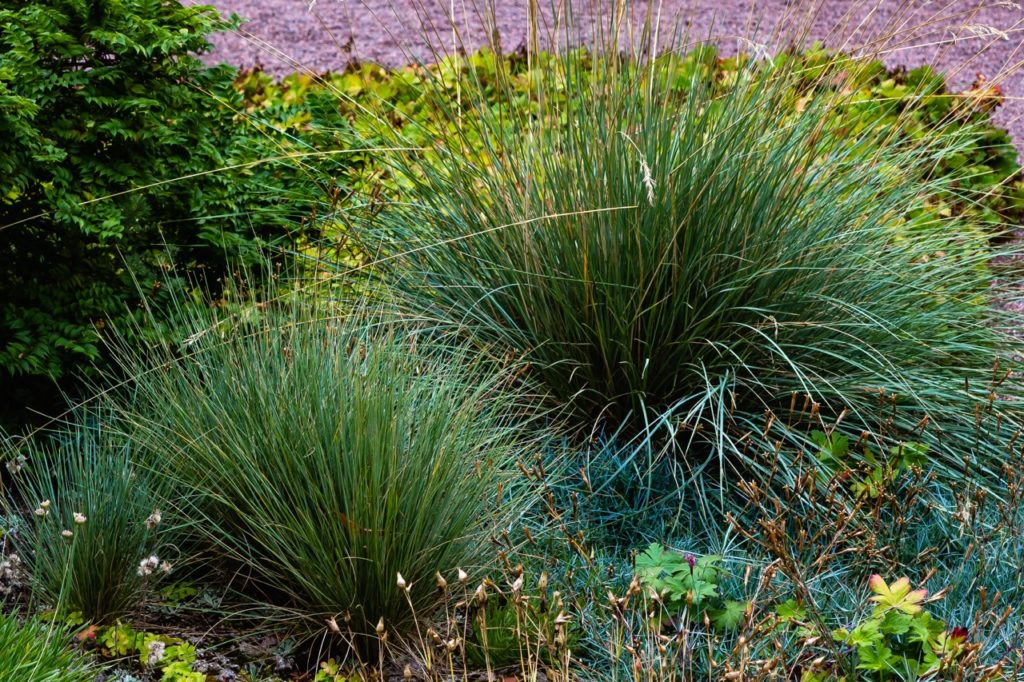
- BOTANICAL NAME: Festuca glauca
- HARDINESS RATING: H5
- PLANT TYPE: grass
- FOLIAGE TYPE: evergreen
- FLOWERS: green
- FLOWERING SEASON(S): summer
- SIZE: 0.1-0.5m in height, 0.1-0.5m spread
Blue Fescue is the second grass-like plant on this list, and, just like Eulalia, is great for pairing with (and complementing) hydrangeas.
With silvery-blue and green foliage, this evergreen is great for planting in garden borders or for filling space in your garden beds.
It is a relatively unfussy plant, but it does require plenty of sunshine, so make sure you don’t plant it in an area that is too shaded.
19) Common Yew
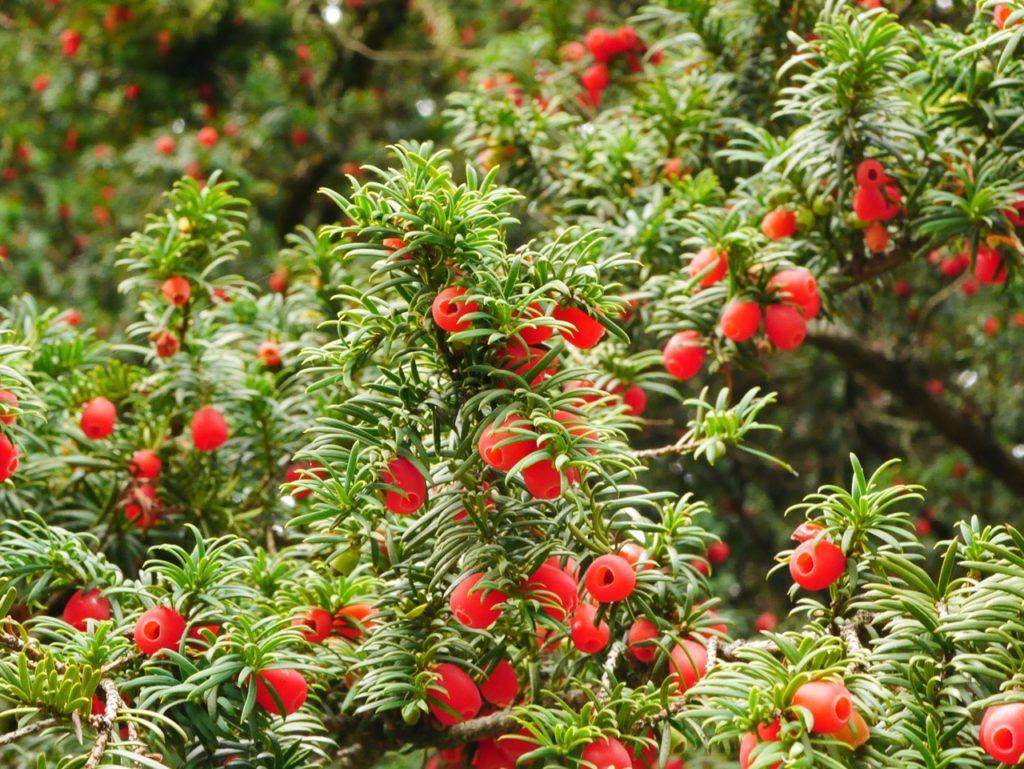
- BOTANICAL NAME: Taxus baccata
- HARDINESS RATING: H7
- PLANT TYPE: tree
- FOLIAGE TYPE: evergreen
- FLOWERS: yellow
- FLOWERING SEASON(S): spring
- SIZE: 12m in height, 8m spread
To finish off this list, I’ve chosen a large tree that is often used for hedging – the common yew.
This tree can reach over 12m in height but can be pruned and shaped to your preferred height.
As a fully hardy, low-maintenance evergreen, this is the best planted behind hydrangeas as a stunning backdrop to its beautiful blooms.
With gorgeous red berries appearing in autumn, this coniferous tree is truly a delight and would make a brilliant addition to any existing flowering display.

